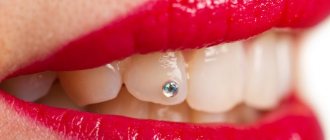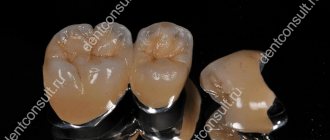Aesthetic dentistry enjoys great success among visitors, along with the therapeutic and surgical fields of science.
In addition to the usual teeth whitening and installation of veneers and lumineers, decorating elements included in the smile area with rhinestones is becoming increasingly popular.
This procedure allows not only to emphasize the individuality of the owner, but also to hide some enamel defects.
Varieties and analogues
Teeth rhinestones are small decorative items that are attached to the enamel without disturbing its integrity using special glue.
These elements are made from different materials - processed glass, amethyst, precious metals and stones.
The shape and size of the products are also very different from each other, so we can distinguish the following types of jewelry:
- Rhinestones are the most affordable option for dental inlay. They are made from transparent or colored glass. The shape of such products can be quite varied, and the surface can be ribbed or smooth.
- Skies are round or oval items made from precious stones. Thanks to high-quality processing, they are securely fixed to the teeth, without causing discomfort during communication and eating.
- Twinkles are flat stones, which are often made of precious metals (gold or platinum), and are also inlaid with precious stones. The shape of the product depends on the wishes of the patient. These can be hearts, flowers, stars, animals.
- Grills are special overlays for the front teeth, made in the form of grilles. They can be made of medical chromium-nickel alloy or precious metals. These products are fixed to the enamel using silicone suction cups and special micro-clips, due to which the jewelry does not damage the surface of the incisors and can also be easily removed from the oral cavity.
- Stickers are a budget decoration option that can be used even by children. A special film is attached to the selected element of the row, on the inner surface of which a pattern is applied. The duration of preservation on the teeth does not exceed 2-3 weeks.
Why is tartar dangerous?
The formation of dental plaque, and then tartar, is possible for various reasons: the involvement of only one side of the jaw, left or right, in chewing; dietary habits, in particular, eating only soft foods; salt imbalance in the body; using low-quality toothbrushes; crooked teeth; smoking. And some people have a congenital predisposition to the appearance of stones. In such cases, even regular care does not guarantee the safety of teeth.
Microbes, which make up 95% of plaque, form acid during their life processes, which, due to tartar, cannot be neutralized by the alkaline environment of the oral cavity. As a result, the enamel is gradually destroyed, and a favorable environment for the formation of caries is formed. Tartar also negatively affects the gums - located between the gum and the tooth, it becomes overgrown with new plaque, which in turn penetrates the gums and causes inflammation. This creates an unpleasant odor in the mouth, gingivitis develops, and with further neglect, periodontitis.
Main differences
Patients often confuse two concepts - rhinestones and skyes, believing that these are the same products.
However, there are several differences between these products, the main one of which is the material of manufacture:
- Various compositions can be used to make dental rhinestones. Most often it is ordinary or lead glass, which has high refractive indices of light, due to which rhinestones imitate precious stones.
No less rarely, in the manufacture of rhinestones, rock crystal is used, the main characteristics of which are high strength and light reflectivity. In addition, dental rhinestones can consist of two materials - crystal and precious stone, from which the upper part of the product is made. - Skyces are made exclusively from precious stones : emeralds, rubies, diamonds.
Their size often does not exceed 2.5 mm. The stones are processed in such a way that the product is securely fixed to the tooth surface. It should be understood that in order to attach a natural diamond or other precious stone to the incisor, it may be necessary to grind off the enamel or drill a hole in the tooth. For this reason, skyces are most often installed on artificial crowns.
Another significant difference between skyes and rhinestones is the duration of their use.
With careful care, skyces can be worn for about 1-2 years, while rhinestones will have to be changed after a few weeks or months.
An important point is the cost of jewelry. The average price for glass rhinestones is about one thousand rubles, while for skyces you will have to pay several times more, depending on the type of stone used.
What was the impetus for the emergence of the trend?
It is believed that it was Madonna who “introduced” the fashion for decorating tooth enamel with rhinestones. During one of her solo concerts, the pop diva simply blinded her fans with a radiant smile, after which skies could be found among many Hollywood stars and media personalities. Of course, in the USA this way of self-expression is no longer unique, but in our country it is only gaining momentum.
Skyces were first manufactured by Ivoclar Vivadent, which produced products made from Swarovski crystals. After this, such famous personalities as Lady Gaga, Riana, Heidi Klum, Katy Perry and others wanted to show off their radiant smile. Of course, Swarovski rhinestones on the snow-white teeth of everyone's favorite pop idols look simply amazing, especially if they are made of blue sapphire or ruby. But not everyone can afford such accessories.
Indications
The main goal pursued by fans of rhinestones is to improve the appearance of their teeth.
Most often, such decoration is preferred by teenagers who want to express themselves, public figures and people who, due to their occupation, have to communicate a lot.
In addition to the desire to attract attention, rhinestones, skyces and other dental products are often used to hide visible enamel defects in the smile area - cracks, chips, pigment spots.
What is an open bite and methods of its treatment. This article is all about teeth whitening using activated carbon.
Follow the link https://dr-zubov.ru/krasota-i-uxod/sredstva/zubnye-pasty/nemeckaya-lakalyut-berezhnyj-i-nadezhnaya-zashhita.html if you are interested in reviews from dentists about Lakalyut toothpaste.
How to install rhinestones on teeth?
The cosmetic procedure of installing a rhinestone or skyce on a tooth should be performed in a clinic by a dentist using professional materials. Securing one decoration takes only 10 – 15 minutes. Installation of the skyce is absolutely painless and without any damage to the enamel. Before gluing the decoration, the tooth surface is thoroughly cleaned and dried. In some cases, safe teeth whitening is recommended. Then a special dental glue and a light-curing composite are applied to it, with which the skye is secured. The procedure is completed by polishing the tooth surface around the rhinestone. If you get tired of flashing a smile, the skys can be easily and safely removed.
Contraindications
Despite the high-quality processing of stones used to make rhinestones and the absence of the need to grind off the enamel, the products have several significant contraindications:
- significant carious lesions on the tooth surface;
- presence of tartar;
- pathologies of the structure of the jaw row;
- increased sensitivity;
- thinning of enamel;
- age up to 12 years;
- allergic reaction to the materials from which rhinestones are made;
- inflammatory periodontal diseases.
Consequences and complications
Dark deposits on the surface of the teeth, bad breath, bleeding gums - these are just the first unpleasant consequences that patients with hard formations face. The problem is that the total volume of tartar is constantly increasing - it penetrates into the gum pockets, which leads to detachment of gum tissue, the development of periodontitis and tooth loss.
Among other unpleasant consequences of unremoved tartar, the following complications can be identified.
- Caries.
- Gum infection and soft tissue abscess.
- Stomatitis.
Important! Timely removal of hard deposits reduces the risk of developing dental diseases and allows you to preserve the beauty and health of your teeth for many years.
How does the installation work?
Fixing dental rhinestones is carried out quite quickly - the whole procedure takes about 15-20 minutes.
However, for high-quality fastening and long-term wear, preliminary sanitation of the oral cavity may be required - teeth whitening, removal of mineralized deposits, treatment of caries.
If there are no contraindications to the installation of rhinestones, the patient chooses the type, the type of fixation will depend on this.
When using thin rhinestones made of artificial material, they are glued; the use of products made of precious stones requires inlay.
Application or gluing is carried out as follows:
- The area of enamel on which the stone will be fixed is cleaned with a fluoride-free paste and dried.
- A special gel is applied to the prepared area of the tooth, increasing its porosity, thereby increasing the degree of adhesion.
- After the gel has dried, a drop of Bond glue is applied to the location where the rhinestone will be located.
- The decoration is placed on the selected area of the tooth and is fixed thanks to the polymerization process, which is triggered when the adhesive composition is exposed to a special lamp.
- At the end of the manipulation, the incisor is polished around the attached decoration.
When installing jewelry that includes precious stones, they are inlaid. This is required due to the significant weight of the jewelry and its more convex shape due to specific cutting.
Dentists recommend installing skyces with precious stones when fixing crowns or, if necessary, decorating a damaged tooth.
The inlay procedure is carried out as follows:
- A hole is made in the selected tooth, the size of which exactly matches the bottom of the jewelry.
- The recess is disinfected and dried, after which a composite material is applied to it. The selected skyline is installed on top.
- The tooth with decoration is exposed to a special lamp, thanks to which the polymer composition hardens, reliably fixing the skye.
Dentists note that preparing your own tooth to install jewelry can lead to a further increase in its sensitivity, so such a procedure should be meaningful.
Find out from the video whether inlays can damage tooth enamel.
What to choose?
If the issue of decorating teeth with appliqué is urgent, you need to calculate the degree of risk. The safest way to decorate is a sticker - it is not expensive, is completely safe for enamel and is easy to remove.
Rhinestones with skys are also relatively safe, however, to fix these decorative ornaments, an adhesive base is used, which affects the enamel. Jewelry in the form of rhinestones and skyes requires certain dietary restrictions - not everything can be eaten and drunk. You must be prepared for this.
Jewelry in the form of twinkles is undesirable: to hold the metal element on the enamel, substances are used that have a destructive effect on its structure. It is better to install Twinkles on “dead teeth” or on crowns.
Inlaying involving drilling through healthy tooth tissue under a precious stone is considered dangerous to dental health. It is better to immediately abandon this procedure or enlay the tooth without a nerve. An alternative is a crown with inlay.
It should be remembered that skyces are incubators of bacterial plaque due to poor quality care of the decorative element. Owners of a shining accessory take care of their jewelry and try to touch it as carefully as possible. As a result, plaque settles on the enamel, which contributes to the development of caries over time.
The pursuit of fashion and beauty always has a downside. If you decide to follow the fashion trend, be prepared to devote enough time to your teeth and give up many of your usual products.
Sources used:
- “Aesthetic dentistry and ceramic restorations (Tuati B.)
- Proffitt U.R., Modern orthodontics (3rd edition), MEDpress-inform, 2015, 560 p.
- Nanodentistry / V.A. Rumyantsev. — M.: Medical Information Agency
Wearing and care
After installing a dental rhinestone, it is necessary to pay special attention to hygiene procedures.
The area around the rhinestone needs careful care to avoid the formation of mineralized plaque and the development of carious lesions.
Dentists recommend following these rules during daily oral care:
- When performing hygiene procedures, it is necessary to use additional means and items - irrigator, rinse aid.
- Teeth brushing should be done at least twice a day. There is no need to worry about the decoration - the brush is unable to damage it, but it will help eliminate bacteriological plaque that accumulates in the uneven enamel.
- While wearing rhinestones, it is advisable to refrain from eating solid foods, biting nuts, seeds, and crackers. When chewing, the load should be evenly distributed throughout the entire jaw row, relieving excess stress on the front teeth.
- Every six months it is necessary to undergo preventive examinations at the dentist to timely identify problems and carry out professional dental cleaning.
Tartar - photo. Tartar - causes of formation. Stones on teeth: what causes them to appear. Supragingival and subgingival tartar – removal.
Table of contents
- What is tartar?
- Causes of tartar formation
- Forms of tartar
- What does the formation of tartar lead to?
- Prevention of tartar
- Preventative toothpastes
- Tartar removal
- How to remove tartar at home
- Description of clinic services and prices
What is tartar?
Tartar is a yellowish or brown layer of mineral hard deposits on the surface of teeth, formed by hardened plaque.
Normally, teeth are almost always present with dental plaque, which represents exfoliated epithelium and food debris. It's hard to notice. After each meal, new food remains, microbes and their metabolic products are added to it. With poor, irregular cleaning, soft and loose plaque, due to increased acidity, causes inflammation in the soft periodontal tissues - gingivitis. Gradually accumulating, with poor cleaning, the plaque hardens and turns into the colors of the products consumed. This causes people to dislike and want to whiten them. Tartar removal is important for oral hygiene because, in addition to being a cosmetic issue, it promotes further plaque accumulation and causes gum inflammation, gum recession and gum disease.
Causes of tartar formation
Anaerobic plaque bacteria produce acids as a byproduct of their metabolism. They create an acidic environment in the mouth, causing calcium to be lost from tooth enamel (demineralization). Calcium, phosphorus and other minerals from saliva are absorbed into plaque and harden. This hardened structure is tartar. Its main ingredient is calcium phosphate, a hard, insoluble material that adheres to tooth enamel.
Tartar roughens the surface of the teeth's crowns and roots, allowing even more bacteria and minerals to "stick" to existing tartar much more easily. The rough surface of tartar, combined with acids derived from bacteria and food debris, provides an ideal environment for further plaque accumulation and growth. Day after day, these repeated cycles of acid production, loss of calcium and calcium phosphates lead to the formation of new layers of tartar on the teeth. As the volume of tartar increases, the risk of space between the tooth wall and the gum increases, which contributes to the development of periodontitis.
The main proven cause of this phenomenon remains insufficient oral hygiene. Regular removal of soft and hardened plaque once every six months will ensure proper prevention of the development of periodontal problems.
Forms of tartar
- Supragingival calculus Supragingival calculus is the most common and less harmful type of plaque as it is easily detectable. But, increasing in volume, it “grows” under the gum, moving it away from the wall of the tooth. Such a movement is very dangerous, because can lead to disruption of the integrity of the ligaments that hold the tooth in the bone socket.
- Subgingival calculus on teeth The formation of calculus occurs below the level of the gums and is more dangerous, since food debris rushes into the formed pocket between the tooth and the gum, which is difficult to clean out from under the gums at home with the usual brushes and dental floss.
What does the formation of tartar lead to?
- Bacteria attach more easily to tooth enamel containing plaque or tartar than to the smooth surface of a tooth. When tartar forms below the gum line, it can lead to serious complications such as gum irritation and damage. At this point, the patient may experience bleeding gums, bad breath and pain when eating. If you do not pay attention to such manifestations of gingivitis and periodontitis, this can lead to the progression of the disease and an increase in symptoms. The roots of the teeth are exposed and the stability of the tooth is lost due to a violation of the attachment of the tooth in the bone socket.
- Removing plaque by brushing and flossing becomes increasingly difficult. Brushing and flossing become virtually impossible when tartar builds up on your teeth. Additionally, acids released by bacteria in the mouth affect tooth enamel, causing tooth decay, tooth loss, or jaw bone degradation.
- Tartar irritates the gum tissue and causes gum recession. Subgingival anaerobic bacteria, which survive without oxygen, are responsible for the development of periodontitis by causing damage to the gums and gingival fiber - which forms the connection between the gum and teeth
- The risk of developing caries and gum inflammation increases.
- Teeth appear unattractive due to stains caused by tartar. In addition to cosmetic problems associated with tartar buildup, such as brown or yellowish teeth, other dental diseases can occur. Against the background of gingivitis and periodontitis, it is difficult to heal postoperative wounds in the oral cavity, it is impossible to carry out orthodontic treatment, and there is a high risk of relapse of caries after its treatment in a “dirty” oral cavity.
Poor oral hygiene and infertility in men
A study has found a link between low sperm count, a cause of infertility in men, and poor oral hygiene. The study found that bacteria responsible for gum disease may also reside in the spermatic cord and affect sperm quality.
Prevention of tartar
- Proper and regular brushing and flossing are essential to reduce plaque and plaque buildup.
- Professional hygienic teeth cleaning by a dental hygienist should be carried out on a regular basis at least once every 6 months
- The use of toothpastes that prevent the formation of tartar, as well as other additional hygiene products, such as a tongue scraper, solutions and foams for irrigating the oral cavity after meals, monotuft brushes, brushes for cleaning interdental spaces, etc.
Remember that it is recommended to brush your teeth after every meal. Using dental floss helps clean the interdental spaces (often toothbrush hairs cannot get there). Chewing gum is also recommended for use, especially without a brush or floss.
Preventative toothpastes to slow down the formation of tartar
They are a special type of toothpaste that can help reduce the formation of new tartar, but they cannot remove existing tartar. They work by reducing the concentration of calcium phosphate in the mouth and absorbing it from plaque, preventing the formation of tartar.
Using them in some cases may cause increased sensitivity to hot and/or cold water/food in some teeth or irritation of the soft tissues of the oral cavity.
Tartar removal
Tartar is too hard on the surface of the teeth. It cannot be removed by regular brushing or flossing (regular plaque removal procedures). Only professional teeth cleaning by a dentist can remove it. Dentists use special instruments:
- Ultrasonic scalers are small thin instruments through which ultrasonic waves are applied to the surface of the tooth and break up hard plaque.
- Curettes and hand scalers are hand-held instruments for removing tartar above and below the gum and smoothing the root surface.
The removal of supragingival and subgingival stone is carried out. In the first case, the procedure does not take more than an hour to remove stone from all teeth. In the second case, a higher qualification of the doctor (periodontologist) is required - because In patients with periodontitis, stone deposition occurs in periodontal pockets.
After ultrasonic cleaning, it is recommended to grind the teeth with a special air-abrasive-water mixture AirFlow.
How to remove tartar at home
Plaque begins to form within 4-12 hours after brushing, so it is important to brush your teeth at least twice a day. Brushing and flossing regularly can help reduce plaque and tartar. Using the following home remedies can help prevent complications from tartar, including tooth decay, gum disease, and bad breath.
- Toothbrushes
- Classic electric brush
- Sonic toothbrushes
- Ultrasonic electric toothbrushes
Description of clinic services and prices
In our clinic you can carry out a full range of all hygienic procedures:
- Ultrasound removal of tartar – 150 rubles
- removal of dark plaque – 150 rubles
- removal of subgingival tartar – 170 rub.
- removal of dental plaque from an implant – 700 rubles.
- complex price for removing plaque and polishing with soda powder – 3,450 rubles.
- complex price for removing plaque and polishing with calcium – 4000 rubles.
{jlcommentspro}
Advantages
The main advantage of installing dental rhinestones is that it gives the smile additional aesthetic appeal, as well as masking some enamel defects that cause a person to feel insecure.
The variety of materials and shapes allows you to choose the best option, taking into account a person’s age, his financial status and existing enamel defects.
Thanks to the use of precious metals and biologically inert materials, the occurrence of an allergic reaction is observed in exceptional cases, with increased human sensitivity.
Another important point is the reliable fixation of jewelry on the tooth surface. If you follow the rules of oral care, the stone will not fall out; a visit to the dentist is necessary to remove it.
Removing skies
Jewelry is removed from the surface of the tooth quite easily, painlessly and quickly. Removing jewelry does not affect the enamel or the condition of the tooth itself; the surface of the teeth remains smooth and healthy.
If you are installing skyces for beauty or to disguise tooth defects, you must know the following information:
- It is advisable to wear dental jewelry for no more than a year;
- If the product looks worn out, it is better to immediately contact a dentist who will remove it;
- Avoid touching the jewelry with your hands and maintain good oral hygiene. For cleaning, it is better to use a special soft brush and oral care products that will not react chemically with the product;
- Heavy smokers and coffee drinkers should think twice before getting dental jewelry, as there may be a major difference in the final color of the jewelry. In this case, it is recommended to perform teeth whitening.
And remember, fashion is very changeable and never lasts long, so before you put jewelry on your teeth, think about the negative consequences that may arise during and after wearing it.
Moscow metro station Zvezdnaya, Danube Avenue, 23
Flaws
In addition to the undoubted advantages, there is also a serious disadvantage that arises when using precious stones.
When a diamond or other stone is inlaid into the tooth surface, the integrity of the enamel is damaged, which can subsequently lead to increased sensitivity of the incisors, especially when eating cold and hot foods.
In addition, after removing the jewelry from the tooth, a hole will remain in its place, which will have to be covered with a composite material in order to avoid the development of caries and restore its aesthetic appearance.
Recommendations and tips on how to properly care for teeth for adults and children. Read here about the diagnosis and treatment methods of pericoronitis.
At this address you will find real reviews about laser dental treatment.
Pros and cons of installing dental accessories
Skyces are used not only to show off a dazzling smile. This method is often used to mask defects in the enamel: small chips, fillings, darkening, etc.
In addition, the product is attached to a special compound, which has very valuable properties:
- prevents the development of caries;
- prevents the growth of bacteria;
- neutralizes unpleasant odors.
All this is possible thanks to the high content of fluorine in the binder composition, which has a beneficial effect on the condition of the enamel.
But the installation of skys itself can also have a negative side.
Firstly, over time, the jewelry fades, so the smile ceases to be so radiant, and secondly, in the case of inlaying the jewelry rather than gluing it on, the enamel is damaged, which somewhat increases the chances of developing caries.
Tips for parents
The desire to stand out among the crowd and emphasize individuality is inherent not only in adults, but also in children.
Parents should not dissuade their children from the new dental trend. Installing rhinestones in a good clinic will not only not cause harm, but will also bring several positive aspects:
- Before installing the decorative stone, the dentist will sanitize the child’s oral cavity, which makes it possible to identify and treat existing diseases.
- To maintain shine for a long time, the child will have to more carefully monitor the condition of the dentition and regularly perform hygiene procedures.
Popular questions and answers
Decorating teeth with rhinestones is a fairly old area of dentistry, however, not everyone knows the details of the procedure.
Patients have many questions, the answers to which are provided by specialists:
- How long does a rhinestone stay on a tooth surface? The duration of wear depends on its type and method of fixation. When using temporary glue, the service life of the decorative element will not exceed 1-2 weeks. Permanent glue allows you to wear the jewelry for about a year. When inlaying a precious stone, this period increases to several years.
- How to remove the rhinestone? The removal procedure is carried out in a dental clinic and takes no more than 10 minutes. The dentist applies a special agent to the adhesive, then removes the stone and polishes the enamel.
- Will there be a hole after removing the skyce? If the gemstone was inlaid into the tooth surface, the hole left after its removal is filled with a composite material. When fixing the rhinestone using the appliqué method, no traces will remain after its removal.
- Is it painful to install rhinestones? The procedure is carried out absolutely painlessly, since there is no violation of the integrity of the enamel.
- Does rhinestone interfere with communication and eating? The first time after installation you may feel slight discomfort, however, after 7-10 days the unpleasant feelings disappear.
Oral Care After Dental Jewelry Installation
Decorative dental jewelry will look beautiful for a long time if you take proper care of your teeth. In order for them to decorate your smile for the entire period stated by the manufacturer - about 3-5 years - you must follow the following recommendations:
- You should brush your teeth thoroughly and regularly, using a gentle cleaning paste that does not contain abrasive particles.
- You need to rinse your mouth with a special mouthwash after each meal.
- The decorative stones themselves must be cleaned using a special product for caring for skyes.
- The use of aggressive pastes, whitening compounds and tooth powder is prohibited. Such products will make stickers, rhinestones or skyes matte and unaesthetic.
- You should not eat excessively hard foods and crack seeds. Such nutrition can lead to premature loss of the sky.
If you need to remove or replace jewelry, or if it falls out, you should contact your dentist. The doctor will remove the sky using ultrasound, without causing harm to the tooth, and properly treat the tooth surface.
Prices
The cost of dental jewelry can vary greatly. It depends on the type and shape of the stone used:
- Glass rhinestones will cost 1000-1500 rubles.
- The cost of a sticker on teeth is 500-1000 rubles.
- When using rhinestones from Swarovski, the price rises to 3000-5000 rubles.
- Skyes with precious stones and metals can cost up to 10,000 rubles.
The video goes into more detail about installing and wearing dental jewelry.
Fastening methods
In modern dental practice, two main methods of attaching skyze to the surface of tooth enamel are used:
- Application. Involves fixing glass decorations and stickers using special dental fluoride adhesive “Bond”. This technique refers to the safest methods of attaching a skyce. It does not damage the integrity of the tooth enamel, and after removing the jewelry, the tooth also does not require restorative manipulations.
- Mounting. It is carried out by inlaying a tooth with jewelry made of expensive stones. This technique involves cutting out a small hole in the tooth for deep seating of the jewelry.
Reference! The specific choice of method for attaching the piercing to the teeth is chosen by the dentist, taking into account the state of the health of the teeth and the type of skypiece being installed.











